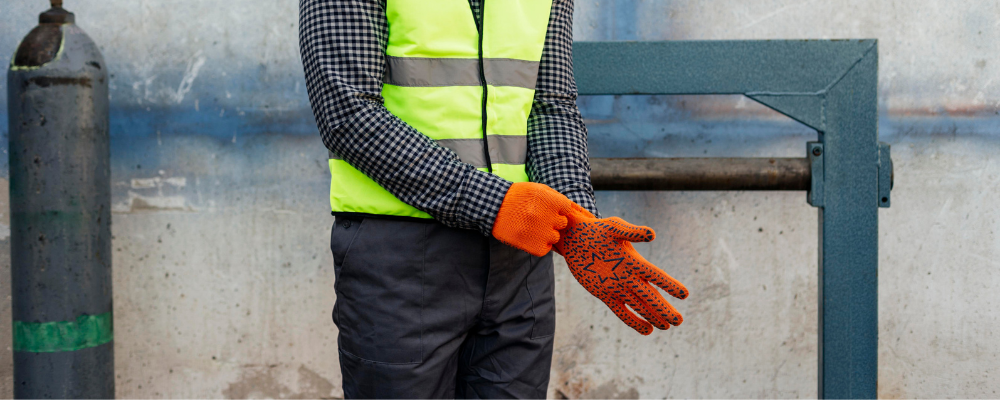
Introduction
The construction sector, a realm of ceaseless physical endeavor, underscores the indispensable need for robust hand protection. Amidst its vibrant activity, the significance of safeguarding hands often remains understated yet pivotal.
Significance of Hand Protection in Construction
The construction industry is fraught with physical risks, and hand injuries stand out as a prevalent concern. According to the Bureau of Labor Statistics statistics, hand injuries constitute a significant percentage of reported incidents within this sector. However, what amplifies the gravity of these incidents is the startling revelation that many of these injuries could have been avoided with adequate hand protection measures.
Numerous studies have shed light on a crucial fact: implementing appropriate hand protection could have mitigated a substantial proportion of these injuries. This underscores the pivotal role that quality hand protection gear plays in ensuring the safety and well-being of those tirelessly toiling in the construction industry. It’s not just about averting injuries; it’s about mitigating the economic burden, preserving workforce health, and sustaining productivity levels crucial to successful project completion.
Understanding Hand Hazards in Construction
In the dynamic environment of construction, various hazards pose significant risks to the hands of workers. Understanding these risks is crucial to mitigating potential injuries.
Common Hand Hazards
a. Sharp Objects: Construction sites abound with materials such as nails, glass, metal, and machinery. Accidental contact with these sharp objects presents a constant risk of cuts, punctures, and lacerations. Workers handling these materials are particularly susceptible to injuries that can lead to infections and severe wounds.
b. Abrasions: Friction caused by rough surfaces, machinery, or handling abrasive materials can result in surface injuries known as abrasions. Despite appearing minor, these injuries can become breeding grounds for infections if left untreated, emphasizing the importance of protection against such hazards.
c. Chemical Exposure: Handling various construction materials and chemicals exposes workers to potential skin irritation, burns, or systemic health issues through skin absorption. The risk of chemical burns or irritations underscores the necessity for adequate protection against these substances.
d. Machinery and Equipment: The operation of heavy machinery and working with equipment, including power tools, poses a significant risk of crush injuries, amputations, and severe trauma to the hands if not managed correctly or without proper protective gear.
e. Repetitive Motion: Engaging in continuous tasks, especially those involving vibrating tools or repetitive movements, can lead to conditions like carpal tunnel syndrome. These conditions cause discomfort, pain, and reduced hand function over time, impacting the worker’s ability to perform effectively.
Prevalent Scenarios
Hand injuries are prevalent in various construction activities:
- Material Handling: Injuries occur during the handling and transporting materials, particularly when workers come into contact with sharp or abrasive substances.
- Equipment Operation: Accidents often happen during the operation of machinery or power tools due to inadequate protective gear or improper handling techniques.
- Demolition Work: Demolition activities pose inherent risks, especially when workers are exposed to sharp objects, heavy debris, and hazardous materials without adequate protection or training.
Inadequate protective gear or insufficient training exacerbates the risks associated with these prevalent scenarios, contributing to a higher frequency of hand injuries in the construction industry. Understanding these hazards is critical for implementing effective preventive measures and ensuring a safer working environment for construction workers.

Impact of Hand Injuries
Hand injuries in the construction sector carry multifaceted impacts, ranging from personal to professional, ultimately affecting the project’s overall success. Understanding these impacts underscores the critical need for comprehensive hand protection measures.
1. Personal Impact
Hand injuries inflict a profound toll on individuals, both physically and psychologically:
- Physical Pain: Hand injuries cause acute physical pain, impacting the affected individual’s quality of life. The discomfort and anguish of these injuries can be considerable, requiring medical attention and rehabilitation.
- Reduced Dexterity: Severe hand injuries often lead to reduced dexterity or permanent impairment. This limitation affects an individual’s ability to perform routine activities, impacting their daily life and potentially limiting their capability to resume work effectively.
- Potential Mental Health Issues: Suffering a significant hand injury can trigger emotional distress, anxiety, or depression. The psychological impact of such injuries shouldn’t be underestimated, as they can significantly affect an individual’s mental well-being and overall outlook.
2. Professional Impact
The ramifications of hand injuries extend beyond the individual, impacting the construction project and its efficiency:
- Economic Consequences: Hand injuries result in direct economic implications, including medical expenses, rehabilitation costs, and potential loss of income during the recovery period. These financial burdens affect both the injured worker and the employer, potentially impacting the company’s financial stability.
- Loss of Workdays: Time away from work for treatment and recovery due to hand injuries directly contributes to reduced productivity. This absence affects project timelines, leading to delays in completion and potential financial penalties for missed deadlines.
- Reduced Productivity: Even upon returning to work, individuals with hand injuries may face limitations in performing tasks effectively. Reduced hand function hampers productivity and efficiency, affecting the overall workflow on the construction site.
3. Overall Impact
Hand injuries don’t only affect individuals; they have wider implications for the entire construction team and project:
- Disruption of Project Timelines: Hand injuries disrupt the planned workflow, leading to interruptions in project timelines. These interruptions can cause cascading effects, delaying subsequent tasks and potentially prolonging the overall project duration.
- Strain on Completion: The cumulative impact of individual hand injuries strains the construction project’s completion. This strain affects the entire team’s morale, introduces uncertainties, and might lead to additional challenges in meeting project goals within stipulated timeframes.
Understanding the significant personal, professional, and overall impacts of hand injuries highlights the importance of implementing robust hand protection measures. By mitigating these risks through adequate protection and fostering a culture of safety, construction sites can ensure the well-being of workers and the successful completion of projects.
Importance of Proper Hand Protection
In the dynamic landscape of the construction industry, the significance of adequate hand protection cannot be overstated. It serves as a crucial shield against many daily hazards, ensuring the safety and well-being of workers engaged in diverse tasks.
Types of Hand Protection Products
In recognizing the diverse hazards prevalent within construction, a spectrum of specialized gloves tailored for specific tasks has emerged, each designed to mitigate distinct risks:
- 4202 Welding Gloves
- Features: Crafted from heat-resistant materials, ideal for welding operations.
- Benefits: Shields against burns, sparks, and heat exposure during welding tasks. Reinforced stitching ensures durability under high temperatures.
- DermiFlex Safety Gloves Black
- Features: Lightweight, breathable, and flexible design for enhanced agility.
- Benefits: Suited for precision tasks requiring tactile sensitivity. It offers protection against abrasions and punctures without compromising dexterity.
- MCR Safety® Pigskin Leather Drivers
- Features: Constructed from durable pigskin leather, providing a comfortable fit.
- Benefits: Excellent grip and abrasion resistance, ideal for operating heavy machinery or tasks necessitating a firm hold.
- Flexo Grip Nitrile Safety Glove Grey
- Features: Nitrile-coated for oil and chemical resistance.
- Benefits: Superior grip in oily conditions, safeguarding against chemical exposure while ensuring hand flexibility.
- Radians® AXIS™ Cut Protection Level A2 Foam Nitrile Coated Gloves
- Features: Engineered with cut-resistant materials and a foam nitrile coating.
- Benefits: Offers high-level cut protection (A2), perfect for tasks involving sharp tools or materials. The foam nitrile coating enhances grip and durability.
Choosing the Right Hand Protection
Selecting the appropriate hand protection involves careful consideration of various factors, ensuring optimal safety and efficiency in diverse construction tasks:
- Fit
- Gloves should provide a snug yet comfortable fit without compromising hand movement or dexterity. Tight gloves may restrict movement, while loose ones pose the risk of accidents.
- Material
- The material choice should align with the specific hazards present in the task. For instance, leather provides abrasion resistance, nitrile offers chemical protection, and specialized coatings enhance grip and durability.
- Durability
- Consider the longevity and robustness of the gloves concerning the demands of the tasks they will be utilized for. Durability ensures sustained protection throughout the project.
Task-specific Guidance for Selecting Appropriate Gloves
- Welding Tasks: Opt for the 4202 gloves to shield against heat, sparks, and burns.
- Precision Work: Choose DermiFlex Safety Gloves Black for tasks requiring dexterity and tactile sensitivity.
- Heavy Equipment Handling: MCR Safety® Pigskin Leather Drivers offer superior grip and durability for operating heavy machinery.
- Chemical Handling: Utilize Flexo Grip Nitrile Safety Glove Grey for protection against chemical exposure.
- Cut-Prone Tasks: Radians® AXIS™ Cut Protection Level A2 Foam Nitrile Coated Gloves are ideal for tasks involving sharp tools or materials, offering high-level cut protection.
By considering factors such as fit, material, and durability, workers can accurately select the most appropriate hand protection, ensuring safety while maximizing efficiency across various construction activities.

Best Practices for Hand Safety
Maintenance Guidelines for Gloves
Cleaning: Regularly clean gloves, especially after heavy use or exposure to contaminants. For most gloves, follow manufacturer guidelines, using mild soap or detergent and water. Specialized gloves may require specific cleaning instructions. Avoid harsh chemicals that could damage the material.
Drying: After washing, ensure gloves air dry thoroughly before reuse. Avoid exposing them to direct heat sources like sunlight or heaters, as this may cause damage or shrinkage.
Inspection: Regularly inspect gloves before and after each use for signs of wear, tear, or damage. Replace gloves that exhibit significant damage or degradation to ensure continued protection.
Storage: Store gloves in a clean, dry area away from direct sunlight and extreme temperatures. Avoid folding or compressing gloves excessively to prevent deformation.
Training and Awareness
Importance of Comprehensive Training: Implement thorough training programs emphasizing the use of hand protection in construction. Educate workers about potential hand hazards, the consequences of neglecting hand safety, and proper glove usage.
Task-Specific Techniques: Train workers on selecting appropriate gloves for different tasks, ensuring they understand the relevance of specific gloves in various scenarios.
Fostering a Safety-Conscious Culture: Encourage a culture where safety is a top priority. Regularly remind workers to use hand protection through safety meetings, toolbox talks, or visual aids. Lead by example, encouraging supervisors and experienced workers to wear gloves consistently.
Compliance and Regulations
Overview of Safety Standards: Highlight and elucidate the standards established by regulatory bodies such as OSHA, ANSI, and NFPA. Emphasize the importance of adherence to these standards, as they outline guidelines for hand protection in the construction industry.
OSHA (Occupational Safety and Health Administration): Stress OSHA’s Personal Protective Equipment (PPE) standards (29 CFR 1926) that mandate providing, using, and maintaining suitable hand protection in workplaces where hazards are present.
ANSI (American National Standards Institute): Explain ANSI standards for glove performance, categorizing gloves based on their resistance to cuts, punctures, abrasions, and chemicals. These standards aid in selecting appropriate hand protection.
NFPA (National Fire Protection Association): Highlight NFPA standards related to hand protection concerning fire and electrical hazards in construction, specifying gloves suitable for these environments to prevent burns and electrocution.
For more information, visit our website and Facebook page.
Here are some products :
MCR Safety® Pigskin Leather Drivers
Flexo Grip Nitrile Safety Glove Grey
Radians® AXIS™ Cut Protection Level A2 Foam Nitrile Coated Gloves
Conclusion
Hand protection is crucial for ensuring safety and productivity in the construction industry. Prioritizing hand safety through compliance with safety standards and adopting appropriate protection measures is indispensable. The diverse tasks within construction present potential hazards, necessitating consistent use of suitable hand protection equipment.
By embracing these best practices—maintaining gloves effectively, providing comprehensive training, and ensuring compliance with safety regulations—workers safeguard their well-being while contributing to a safer and more efficient work environment. This collective commitment ensures personal safety and promotes a culture where hand safety is paramount.









